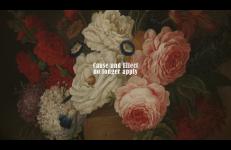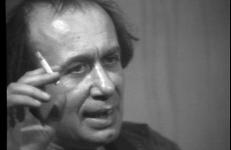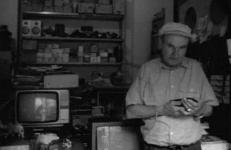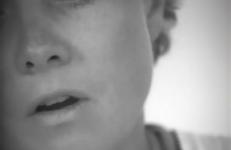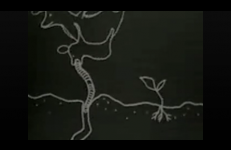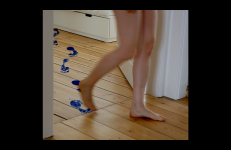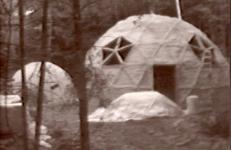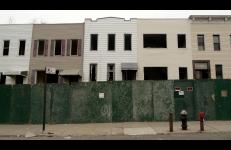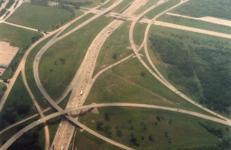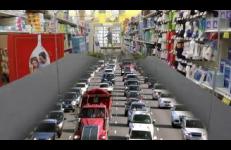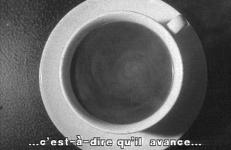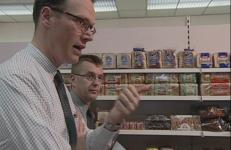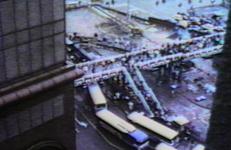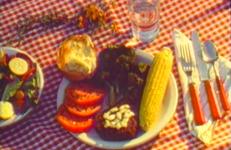3 Church Walk is a film made with writer Jonathan P. Watts and sound composer Simon Limbrick about the empty and neglected Suffolk house of modernist architect H. T. ‘Jim’ Cadbury-Brown.
Architecture
In an upmarket house surrounded by an idyllic garden, there is no trace of human presence, even though a family obviously lives there. Voices, sounds and superimposed text create a feeling of disquiet whose origin continually escapes us. “A house can feel pain”… Playing on a doubling of vignettes against a black background or on a sound design that brings the off-screen world to life, Shelly Silver resuscitates the memory of this space, if only because a “house is a subconscious… a body…” And what if all this opulence and comfort were based on the exploitation of others?
Vito Acconci (b. 1940) is known as a conceptual designer, installation and performance artist. In the 1960s he embraced performance in order to "define my body in space, find a ground for myself, an alternate ground from the page ground I had as a poet." Acconci’s early performances, including Claim (1971) and Seedbed (1972), were extremely controversial, transgressing assumed boundaries between public and private space and between audience and performer.
A portrait of an unnamed city in Italy. Sidestepping the tourist attractions that make the city famous, the film/video posits an almost-imaginary place that draws closer to the reality of its inhabitants. Using a voiceover narration that collages direct observation, literary texts, historical fact, local folklore, and a bit of sheer fabrication, the film/video melds documentary and narrative, past and present.
An all-over textile constructed under the spell of Arachne, an audiovisual textile in five parts that exposes a web of raids in construction over the american houses, a landscape of protests under the webs of segmented time, the entrails of the american factory in movement through the endless american party.
San Francisco is a city where the virtual and the real co-exist. It is both a center of multi-media and Internet activity, and a city with a vibrant street life and commitment to public space. Awakening From the 20th Century explores these issues by asking the questions: Is life becoming virtual? Are we witnessing the end of the city? Will the computer replace the automobile?
This title is also available on Chip Lord Videoworks: Volume 2.
During her graduate studies at Hunter College, Alice Aycock (b. 1946) began to forge links between personal and more inclusive subject matter and form. In her quest for contemporary monuments, Aycock wrote her Master’s thesis on U.S. highway systems. Aycock’s large environmental sculptures create intense psychological atmospheres. Although she uses primitive rites and architecture as sources, her implementation of contemporary materials removes those specific connotations.
The Bats details the mating habits of flying mammals in an abandoned Mayan temple in the 14th Century.
This title is only available on Soft Science.
Beach House is a film about a unique example of rural modernism built on the UK coast of Suffolk by the architect John Penn. As well as being an architect, Penn was a painter, musician and poet. Beach House is one of nine houses Penn built across East Suffolk, each of which features designs of uncompromising symmetry, adhering to the points of the compass in their positioning in the landscape.
Block is a round-the-clock portrait, shot over a duration of ten months, of a 1960s tower block in south east London. The film is a portrait that developed out of this long duration spent there. Patterns of activity around the block build a rhythm and viewing experience not dissimilar to the daily observations of the security guard who watches the flickering screens with their fixed viewpoints and missing pieces of action.
In our 'freelancer' age in general, even before the lockdowns, many find themselves domestically confined, using mostly a computer screen to branch out. This film brings nature, lunacy, emotion and humanity indoors, using the color blue as the main protagonist. Blue is a part of Ann Oren’s video journals, a short video series responding to media culture and Instagram specifically with the square format, often starring animals.
A great example of early 1970s counter-cultural activity and the influence of Buckminster Fuller. The video, shot in Woodstock, NY in November 1971, includes footage of a communal meal being eaten in the woods, and of children playing in the mud. The video goes on to document the building of a geodesic dome. As the group works, many of them naked, they are interviewed to camera, and explain how to build a dome.
"This film is closely related to my last feature-length project, Counting. I take the temperature of a neighborhood. In this case, the place is my New York. I think about street life and its threatened demise – a death ushered in as Big Money relentlessly re-makes cities in ever more categorical ways. I think with the camera, on the move, in fragments.
As regional character disappears and corporate culture homogenizes our surroundings, it's increasingly hard to tell where you are. In Chain, malls, theme parks, hotels and corporate centers worldwide are joined into one monolithic contemporary "superlandscape" that shapes the lives of two women caught within it. One is a corporate businesswoman set adrift by her corporation while she researches the international theme park industry. The other is a young drifter, living and working illegally on the fringes of a shopping mall.
A fairy tale, a road movie, a folly. The image of the road — black-top and broken white line — the most familiar and most fantastic sculptural installation; a worldwide work of art, which one sees everywhere and generally files under: "Are We There Yet?"
Each film in this series is a condensed experience of a feature film, a single 360-degree time lapsed shot in an empty cinema where the sound becomes a cacophony of past projections and the aural experience is closer to that of the projectionist than the audience.
Filmed from the artist’s window during lockdown, Citadel combines short fragments from British Prime Minister Boris Johnson’s speeches relating to coronavirus with views of the London skyline recorded in a variety of weather conditions. Recognising the government’s decision to place business interests before public health, it relocates the centre of power from Parliament to the financial district of the City of London.
C.L.U.E. (color location ultimate experience), Part 1 is a collaborative video and performance work by artists A.L. Steiner and robbinschilds, with AJ Blandford and Seattle-based band Kinski. Inhabiting the intersection of human movement and architecture, A.L. Steiner and robbinschilds (Sonya Robbins and Layla Childs) present a full-spectrum video, set to a score by rock quartet Kinski.
C.L.U.E. (color location ultimate experience), Part 1 is a collaborative video and performance work by artists A.L. Steiner and robbinschilds, with AJ Blandford and Seattle-based band Kinski. Inhabiting the intersection of human movement and architecture, A.L. Steiner and robbinschilds (Sonya Robbins and Layla Childs) present a full-spectrum video, set to a score by rock quartet Kinski.
Cobra Mist explores the relationship between the coastal landscape of Orford Ness and its traces of military history, particularly the extraordinary ruined architecture of experimental radar and the Atomic Weapons Research Establishment. Still under the official secrets act, much of what took place on the Ness will only be revealed over time. Military buildings have been left to the elements to deteriorate, creating a tension between the time it will take for their secrets to come out and for the buildings to disappear.
"This video in two parts is a newcomer's portrait of Montréal, and focuses on two of my architectural obsessions: the Hydro Québec building and the Métro. I spent my first winter in Montréal in a cold, dark, first-floor apartment. I sat in the kitchen beside the electric heater, drinking coffee and watching the disk on the electric meter spin faster and faster, all the while wondering how I would manage to pay the bills. At night, I lay in bed and looked at the enormous illuminated 'Q' on the Hydro Québec building and wondered how much it cost to keep it lit every night.
Brave new shopping worlds are being created. What have mall owners, architects, surveillance technicians, and supermarket workers done to turn human subjects into pure streams of consumers, into the perfect inhabitants of shopping mall paradise?
“But we are alone, darling child, terribly, isolated each from the other; so fierce is the world’s ridicule we cannot speak or show our tenderness; for us death is stronger than life, it pulls like a wind through the dark, all our cries burlesqued in joyless laughter; and with the garbage of loneliness stuffed down us until our guts burst bleeding green, we go screaming round the world, dying in our rented rooms, nightmare hotels, eternal homes of the transient heart.”
—Truman Capote, Other Voices, Other Rooms (New York: Random House, 1948)
A Kafkian vision of the New World. The arrival of Karl Rossman to the contemporary Babylon under the spell of the paranoid avant-garde. Kinetic coexistence of the archaic forms in dissolution.
The first of the series includes:
What Does Away Mean? by Jem Cohen advertises the need to recycle through reconsideration of landfills and garbage disposal.
Pro-Choice is Pro-Life by Jane Pratt makes its point with the simple logic that every child should be cared for and wanted.
Historic Preservation by Jim McKay counsels for the preservation of historic buildings endangered by urban decay.





